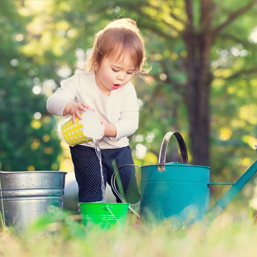
There’s no question that H2O, in all its forms, is fascinating to young children. When given opportunities to explore water and how it feels, tastes and looks, children’s natural curiosity about the world in general increases. I love providing my kids, both at home and school, opportunities to play with water in all of its different shapes. Here are some of our favorite ways to play!
Liquid
Water in its liquid form is super engaging for preschoolers, and while they play, they are learning so many scientific and mathematical concepts. A water table is one of the easiest ways to provide these opportunities to young children. Through activities like scooping, pouring, transferring, testing, floating and sinking, children are able to develop an understanding of concepts like motion, flow, measurement and buoyancy. You can purchase water tables online or at local department stores, but what’s the simplest way to get this play happening at home? A table with a large, shallow, rubbermaid storage container on top! Add some measuring cups, funnels and small toys, and you have yourself a budget-friendly water play station.
Solid
Ice is a wonderfully tactile, sensory experience, providing opportunities to hone in on fine motor skills while learning about the properties of water in both its liquid and solid form. We love making frozen dinosaur eggs with mini figures. Simply fill a balloon with water and a mini plastic dinosaur or other small toy. Tie the balloon and freeze overnight. Remove dino eggs from the balloons and provide droppers, small tools, fabric and other materials and challenge children to free the dino!
Another fun way to explore ice is by making frozen paint. Fill ice cube trays half full with tempera or water based acrylic. Top with water. Freeze for a few hours before sticking a popsicle stick in the top. Once they are completely frozen, remove the paint cubes from the trays and have children use them to create beautiful, frosty, masterpieces!
Surface Tension
Water has a thin, elastic, skin-like property called surface tension. You can see this when you drop a bead of water onto a surface… the surface tension is what holds it together and creates the dome shape. Older children can play with this concept using a penny and some small droppers. How many drops of water can you get to stay together before the water spills over? This may seem like a pretty simple challenge, but from experience I can tell you it is highly engaging to students and children!
We also love to explore surface tension by playing with giant bubbles. Start by dissolving half a cup of cornstarch into six cups of water. Add a tablespoon of baking powder, half a cup of dawn dish soap and one tablespoon of glycerine. Mix and let rest for one to two hours. Giant bubble wands are available for purchase in toy stores or online. We love these bubbles for hours of entertainment outside in the summer. Basically, a bubble is just air wrapped in soap film, but you can get even more specific and talk to your kids about topics like surface tension, light and elasticity!
Absorption
Absorption occurs when a material takes in, and holds water (the easiest explanation for your preschooler). Adding different shapes, sizes and colors of sponges to your water play area makes for a unique sensory experience, and an opportunity to explore absorption. Sometimes I prompt my kids with the task of transferring water from one container to another using only sponges. Another super absorbent play material is Orbeez. When combined with water, these little beads swell up to 150 times their size in just a few hours. They create a squishy, slimy base that can be placed in sensory bins or water tables and explored in various ways. Keep in mind that many sensory bases (like water beads) are not edible, so adult supervision is important.
Remember, water (like all sensory play) is the perfect opportunity to explore the world together, to connect with your child, and to promote language development. Take this time to be involved and talk with your child. You might prompt discussions with a question like… what do you notice? How does it feel? Does it remind you of anything? Are you being careful when you pour the water? Can you tell a story using the materials?
Sensory play contributes to your child’s development, strengthening motor skills, cognitive functioning, language, socialization, mathematical understanding and imagination. It builds nerve connections in the brain’s pathways, leading your child to be able to complete more complex learning tasks in the future. In my opinion, water is the ultimate sensory base because it’s readily available, affordable and so engaging for preschoolers!
For more water play activities, follow Ashley on Facebook and Instagram @teachthemlittle. Ashley Frampton is a mom of three, Early Childhood Educator, and Elementary Teacher. She has a Master’s Degree (Instructional Leadership) from the University of Calgary and loves inspiring families, educators, and caregivers to help their children learn at home and school.
Calgary’s Child Magazine © 2024 Calgary’s Child